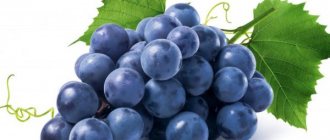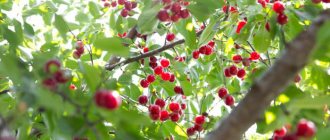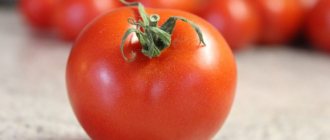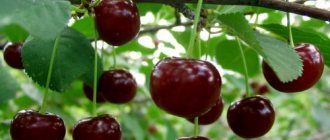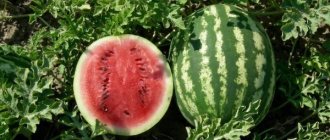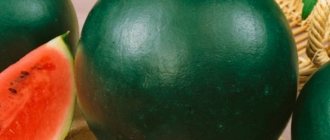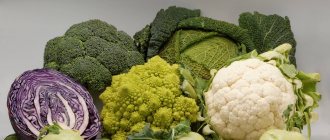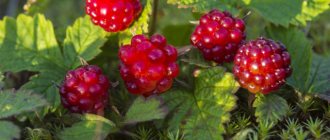January 14, 2021
Hello, dear readers of the KtoNaNovenkogo.ru blog.
Summer is a great opportunity to enjoy seasonal fruits to the fullest, and if in June we happily eat strawberries, smoothly moving on to July peaches and apricots, then in August we are already waiting for a sweet and juicy watermelon, which allows us to eat and get drunk at the same time.
What secrets does this fruit keep, and is it correct to call it that? We will answer this and other popular questions among striped fruit connoisseurs in this article.
Watermelon is a fruit or berry
The answer to the age-old question, what is a watermelon, fruit or berry, is quite simple. In botany there is a clear classification. According to it, a berry is a multi-seeded fruit with a relatively thin leathery shell, juicy pulp and seeds in a hard peel.
Thus, watermelon, along with other representatives of the pumpkin family (including melon, pumpkin and even cucumber, which is more familiar to us as a vegetable), meets these criteria, therefore, from a scientific point of view, it is a berry.
Why then is it common for people to call watermelon a fruit? If in the first case we started exclusively from terms established by plant science, then everyday life and cooking have their own concepts.
It is believed that a fruit is any large fruit that is bitten off piece by piece or cut with a knife, while the berries are consumed whole.
What conclusion can be drawn from all this? Firstly, from the point of view of science, a watermelon is a berry, despite its size relative to the more familiar gooseberries, currants, raspberries and so on.
Secondly, you need to understand that there is no such thing as a fruit in botany. However, calling them a watermelon in everyday life would not be a mistake.
What family do watermelon and melon belong to?
Both plants belong to the pumpkin family (Cucurbitaceae), but belong to different genera. The common watermelon species belongs to the genus Watermelon, and the melon belongs to the genus Cucumber (which also includes the common cucumber species). Their resemblance to the common pumpkin is easy to notice. Members of the family have similar growing and care requirements and similar physical characteristics. For example, all the crops in this family are sprawling, climbing vines that typically have tendrils and bright yellow flowers.
Important! Inexperienced gardeners often do not know what the consequences of planting melons and watermelons close together can lead to, and
they fear that the plants will undergo cross-pollination.
In fact, cross-pollination is only possible between members of the same species, which absolutely does not apply to these plants, so these crops can easily grow in neighboring beds. From the above, it becomes clear that watermelon and melon, despite their noticeable similarities, are quite different. But for the average consumer it doesn’t matter too much whether it’s vegetables, berries or fruits - it would be tasty and sweet.
How does a watermelon grow?
Watermelon is a plant that loves a lot of light and heat, so it is mainly grown in the southern regions. It is not at all afraid of drought thanks to its powerful root system, which can penetrate the soil to a depth of up to a meter and has great moisture absorption power.
Excessive moisture, in turn, can lead to slow growth of vines, delayed flowering and a decrease in fruit sugar content.
If the watermelon grows in conditions of constant rain and cloudy weather, or in the shade due to the field being clogged with weeds, then its fruits will ripen longer, will be smaller in size, and less sweet in taste.
Optimal conditions for growing watermelons:
- Ambient temperature for normal ripening is 25–30°C;
- Soil type - sandy, well aerated;
- Sowing technology - depends on the type of watermelon, the desired weight of fruit, etc.;
- Irrigation technology - furrow irrigation, sprinkling or drip irrigation.
The fruits are usually harvested at the end of summer, when the fruit pulp (scientifically called mesocarp) acquires a sweet taste, crispy texture and rich red color.
Farmers can determine the degree of ripeness of the fruit by such signs as dry tendrils or stipules near the stalk, the presence of a waxy coating on the peel, the appearance of a yellow soil stain, as well as a characteristic sound when tapped.
How to grow a square watermelon
At one time, photographs of square watermelons confused many people. Exactly until the secret of this non-standard shape of the initially round (more precisely, spherical) fruit was discovered.
The cunning growing technology was invented more than 30 years ago on the Japanese island of Shikoku. Local farmers simply placed the unripe fruit in a plastic or glass container of the appropriate shape.
This was usually done at the stage when the watermelon reached the size of a large apple, and within about 30–45 days it acquired unusual shapes.
Over time, Japanese melon growers learned to grow pyramid-shaped berries. True, their taste was still the same, like the familiar round watermelon.
How to choose a watermelon
It is better to purchase watermelons no earlier than August; to choose ripe and sweet ones, rely on the tips described below.
- The watermelon must be without damage, no cracks or scratches, otherwise there is a possibility that microbes could have already entered the pulp.
- The clearer the stripes are visible, the better. Bright green stripes indicate that the pumpkin has been in the sun for a long time and is already ripe, which means it is sweet and juicy.
- A yellow spot on the peel; the smaller it is, the riper the watermelon. In ripe fruits, the spot can be from 5 to 10 cm, no more.
- Rub the peel lightly with your finger; if you smell hay, the watermelon is most likely not ripe.
- More doesn't mean better. Large watermelons can only be the result of nitrates; it is better to choose medium-sized specimens, weighing up to 20 kg. Very small ones should also be avoided; most likely they were picked early and did not have time to ripen.
- If you knock on a ripe watermelon, you will hear a distinct loud sound. If you squeeze a ripe watermelon, you will hear a cracking sound.
- We look at the tail; ripe fruits have a dry, yellow tail. A green juicy tail indicates that the watermelon was picked early. The absence of a tail may mean that the seller is hiding something from you. This method cannot be called accurate, since sometimes in unripe fruits they also dry out over time.
- It is better not to buy watermelons from unknown sellers. At markets it is worth asking for special certificates, which will indicate where and when the watermelons were collected, and may also indicate the presence or absence of nitrates.
Popular varieties
There are a lot of varieties of watermelon, so to organize them, a separate classification was even created according to geography, which included 10 conditional groups of varieties of striped berries:
- Russian;
- Western European;
- American;
- Indian;
- Transcaucasian;
- Afghan;
- Asia Minor;
- Central Asian;
- East Asian;
- Far Eastern.
In Russia, the following varieties of watermelons have become most popular:
| Variety | Description |
| Ogonyok | An early variety with a characteristic dark green peel without stripes, spherical shape and low weight (usually up to 2.5 kg). |
| Astrakhan watermelon | A mid-early variety, considered unpretentious, has a round or oblong shape, dark green skin with light stripes, and usually reaches large sizes (average weight 8–10 kg). |
| Crimston Suite | Sugar variety weighing from 3 to 8 kg, ripens very early, has a characteristic color with dark and light green stripes. |
| Sorento | An early hybrid with spherical dark green fruits with light green “ragged” spots, reaching a weight of about 5 kg. |
| Charleston | An early-ripening hybrid with elongated fruits that can weigh up to 10 kg, and sometimes up to 18 kg. The skin is bright green and shiny, but some varieties, such as Charleston Gray, have a gray-light green tint. The pulp is bright pink. |
In fact, this is not a complete list of varieties of watermelons that can be found on the shelves of Russian stores. Moreover, the popularity of a particular variety may depend on the specific region of the country.
The most unusual watermelons (including yellow)
In addition to the previously mentioned square watermelons, there are several more varieties that deserve attention:
- Giant watermelon. In 2005, a record was set for the maximum weight of a watermelon: a 122-kilogram berry was grown by Arizona farmer Lloyd Bright, who subsequently donated the fruit to parishioners of a local temple.
As those who managed to try a piece of Carolina Cross (this is the name given to the giant watermelon) said, it tasted very sweet.
- The world's smallest watermelon. Among all representatives of melons, the Pepquinos variety of watermelons, which grow in the wild forests of South America, are considered the smallest. Their pulp is not sweet at all, but neutral, reminiscent of a cucumber in taste. Often served as a delicacy in expensive restaurants around the world.
- Yellow watermelon. Pulp of such an unusual color is rare, but one should not assume that there is only one such variety in the whole world. In fact, there are quite a lot of watermelons with yellow “filling”. For example, the “Vector” variety has a taste with a pronounced muscat tint.
Bred in Astrakhan, “Moonlight Watermelon” has a light lemon note. In addition to them, you can also try “Surprise”, “Miracle Berry” and other varieties with yellow flesh.
- Watermelon is yellow. The “Gift of the Sun” variety has the main highlight - not the pulp, but the golden skin with faint stripes. Oddly enough, it does not look like a melon: its fruits are round and quite slightly elongated, smooth and, as a rule, not very large (within 2–4 kg) with delicate pink-red pulp.
- Black watermelon. The Densuke variety is considered the most expensive in the world. It was developed in Japan and became famous for its unusual peel. It has a black color and a glossy surface, thanks to which the berry looks very exotic.
- White watermelon. The pale green skin of the fruit is not its only feature. The pulp inside is really white, and this cannot but surprise. This melon-watermelon hybrid is very popular in the USA.
- Seedless watermelon. “Red King” is a unique variety, bred using selective breeding methods, which does not have seeds, making it more convenient and pleasant to eat, and when cut, it looks simply perfect.
The appearance of unusual varieties is the result of constant experiments by breeders who regularly cross one melon crop with another to obtain new hybrids.
Among them is a yellow watermelon. What is this variety crossed with, you ask. It's simple. About 20 years ago, breeders decided to use wild watermelon as a basis, which actually had yellow flesh that was unsuitable for consumption.
It was crossed with a “classic” variety with a red core, and the result was a new unusual fruit. First, this experiment was carried out in Italy and Thailand, and later in other countries, including Russia.
Composition of watermelon
Everyone knows that eating this berry quenches not only hunger, but also thirst. This is not surprising, because per 100 g of its pulp there are 89 g of water. At the same time, the berry is rich in useful microelements and vitamins.
Watermelon contains:
- easily digestible carbohydrates (glucose, fructose, sucrose);
- fiber (about 0.4 g);
- potassium (110 mg);
- magnesium (10–12 mg);
- phosphorus (7 mg);
- iron (no more than 1 mg);
- sodium (up to 16 mg);
- silicon (up to 12 mg), etc.
What vitamins
Mostly representatives of group B (B1, B2 and B9), as well as PP, A, C. Each seed, in turn, contains up to 25% fatty oil, so the seeds from an eaten watermelon can be crushed and used for cosmetic purposes.
The benefits of watermelon
It is believed that not only the pulp and juice of watermelon, but also the seeds and even the rinds have medicinal properties:
- Natural watermelon juice removes salts, so it is recommended for use for arthritis and gout.
- A decoction of watermelon peel is a good folk remedy for the treatment of migraines, cystitis and nephritis, but can also be used for preventive purposes to slow down the aging of the body.
- If you crush watermelon rinds and apply them to your face as a mask, you can improve your skin color and increase its elasticity.
- A mask based on watermelon seeds is a proven remedy for fighting acne, but if you eat them, it will help get rid of worms.
- Watermelon juice, like its pulp, is a potent natural diuretic. If you add it to your diet (at least during the summer season), it will ensure the removal of waste from the kidneys, prevent salt deposits and prevent the formation of kidney stones. Another useful property of the pulp is the normalization of intestinal motility.
- Watermelon seed oil is similar in its physical and chemical properties to almond oil, therefore it is a cheaper substitute.
Daily consumption of watermelon during the season allows you to activate blood circulation and increase the elasticity of blood vessels, relieve swelling, cleanse the body of toxins, and also reduce uterine and nasal bleeding. In addition, it has antipyretic, laxative, choleretic and immune-strengthening effects.
Beneficial features
There is nothing strange in the fact that a fruit with such a unique chemical composition has a wide range of effects on the body. Here are just some of the beneficial properties of watermelons.
- Heart and blood pressure.
Lycopene, citrulline and arginine contained in watermelons reduce the risk of developing cardiac diseases, improve blood flow and effectively regulate blood pressure in obese people. In addition, potassium and magnesium, which are also found in significant quantities in watermelons, have a positive effect on blood vessels and the heart.
- Anti-inflammatory properties.
Watermelons fall into the category of “anti-inflammatory fruits” due to the presence of lycopene in their composition. This substance is an inhibitor for various inflammatory processes, and also works in the body as an antioxidant, neutralizing free radicals. Watermelons also contain choline, which is known to be useful for treating chronic inflammation. In particular, this substance makes the berries beneficial for people with arthritis.
Working together, all these substances strengthen the immune system, thereby improving overall well-being.
- Hydration.
Watermelons are a great example of a food that will help restore water balance in the body. They are not only maximally saturated with water, but also contain useful electrolytes. Together, this helps prevent heat stroke. For this purpose, in tropical countries, many people eat this fruit every day throughout the summer.
- Digestion.
The fiber that watermelon is made of has a beneficial effect on the gastrointestinal tract and also helps maintain normal weight.
- Skin and hair.
Vitamin A is a substance without which skin and hair cannot look beautiful. And it’s worth noting that just a 100-gram slice of watermelon contains almost a quarter of the recommended daily intake of this vitamin. In addition, the fruits are rich in ascorbic acid, which promotes the production of collagen and elastin, necessary for the healthy growth of epidermal cells.
- Benefits for bodybuilders.
Research conducted in 2013 showed that watermelon juice is essential for athletes. It turned out that in order to reduce muscle pain after intense training, it is enough to drink about 500 ml of juice 1 hour before exercise. Scientists are still at a loss as to what could cause this effect. But there is an assumption that this is the “work” of the amino acids citrulline and arginine, which are found in high concentrations in watermelons.
- Cancer prevention.
Like many fruits and vegetables, watermelon belongs to the anti-cancer food group. Not least due to its antioxidant properties. In particular, experiments have shown that lycopene prevents the proliferation of prostate cancer cells and reduces the risk of breast, intestinal, and lung cancer.
- Insulin resistance.
Insulin is an important hormone in the human body, which directly affects the level of sugar in the bloodstream. Insulin resistance is a condition in which the gland produces insulin, but the cells are resistant to its effects. This condition can lead to type 2 diabetes. Watermelon juice, according to some studies, can reduce the level of resistance, thereby preventing the risk of “sugar disease”.
- Kidneys.
The spectrum of beneficial substances that form the chemical composition of watermelons includes potassium, which is very useful for removing toxic deposits in the kidneys. In addition, this element is useful in reducing the concentration of urea in the bloodstream, which in turn reduces the risk of kidney damage and the formation of kidney stones.
Among other things, do not forget that watermelons are more than 90 percent water. Therefore, they are an excellent diuretic, which is also good for cleansing the kidneys.
- Vision.
You don't have to worry about your eye health if you have watermelons in your diet. This fruit, rich in beta-carotene, vitamin C, and lutein, has an excellent effect on vision. The listed components protect against drying out of the mucous membrane of the eyes, the development of glaucoma and cataracts.
Harm from watermelon
Surely you may have heard about watermelon diets, but are they really that good? It turns out that the sweet pulp contains simple sugars, which are quickly broken down into glucose in the body, which is why the seasonal fruit may be contraindicated for diabetes, as well as for those who want to lose weight.
Despite the relatively low calorie content (only 25 Kcal), the glycemic index of watermelon is 65–70 units, and for a well-ripened fruit it is all 75.
So it turns out that abuse of this sweet berry leads to an increase in glucose levels, and this, in turn, stimulates the production of insulin. As a result, this leads to the accumulation of fatty deposits, and in people suffering from diabetes - to exacerbations. By the way, everyone’s favorite melon has similar indicators, which should also be excluded from the diet if you are trying to lose weight.
Contraindications also include diseases such as:
- urolithiasis disease;
- colitis;
- stomach upsets (diarrhea and flatulence).
In addition, watermelon is not recommended for consumption by children under 2 years old, unless, of course, we are talking about a berry grown in one’s own garden under environmental conditions.
The younger the child, the less his body is able to withstand the harmful effects of nitrates, toxins and microbes contained in store-bought and, especially, “roadside” and untested fruits.
Use during pregnancy and diet
Representatives of the fair sex who are expecting a baby should use this product with extreme caution. Only the treating specialist can recommend the permissible dosage. Naturally, the vitamin composition and microelements are quite useful, but many pregnant women experience swelling, high blood pressure, urolithiasis and diarrhea. In some situations, the condition may only get worse.
This is especially true for the initial period of gestation. But in the last months it is better to completely abandon the berries. This is due to the fact that due to the large volume of fluid in the body, excessive heaviness will appear, and premature contractions may also occur.
During the diet period, the berry can be consumed in large quantities, since the product is low-calorie and quite nutritious. Many people take great pleasure in arranging fasting days for themselves. At the same time, only watermelon is present in their daily diet. Thanks to this, the body is saturated with vitamins and microelements , cleansed of unwanted waste and toxins, and also creates a large volume in the stomach, which dulls the feeling of hunger.
It is worth noting that such a diet can only be recommended by a nutritionist, since there are still some contraindications for use.
Watermelon poisoning
Watermelon poisoning is not uncommon. Unfortunately, some unscrupulous farmers, in pursuit of large fruits, abuse the feeding of plants with fertilizers. To speed up the growth of early crops, they use nitrates, which make a harmless product a source of trouble for the human body.
Nitrates themselves are low-toxic, but when they enter the microflora of the gastrointestinal tract, they are converted into harmful nitrites and N-nitroso compounds, which can cause cancer and lead to human poisoning.
Gastrointestinal upset usually manifests itself within a few hours after eating the berry, but for some it occurs only on the second or even third day. If watermelon poisoning occurs, the symptoms will be as follows:
- The first signs of poisoning: abdominal pain, nausea and vomiting, loose stools, general weakness and malaise.
- Secondary symptoms: high fever (more common in children), low blood pressure, rapid heartbeat and shortness of breath (in severe poisoning).
Please note that the nitrite content in watermelon also increases when the ripe fruit is stored for a long time, especially in conditions of high humidity.
As such, treatment is not provided for watermelon poisoning. A person needs to drink as much fluid as possible to induce vomiting and thus get rid of toxins. After this, it is necessary to arrange bed rest for him. In especially severe cases of poisoning, call an ambulance.
Popular myths about watermelons
We have already dealt with several common misconceptions: we found out that it is a berry, why the watermelon diet is not as effective as they say, where the square and yellow fruits come from. However, there are many other types of myths that we will also try to dispel.
Myth 1. Red watermelon is the sweetest
In fact, sweetness does not depend on the color of the pulp. Moreover, the core of a ripe berry of different varieties may differ in shade, but at the same time be equally “sugar”.
What should really alert the buyer is the uncharacteristically dark flesh, as well as the presence of large yellow or white veins.
If in the first case we are talking about damaged and spoiled fruit, then the second is a clear sign that all sorts of “chemicals” were used when growing the watermelon.
Myth 2. All watermelons are divided into “boys” and “girls”
It is generally accepted that “girls” (fruits with a large “circle” on the opposite side of the tail) are sweeter than “boys”. We hasten to disappoint you. When watermelons bloom, they produce male and female flowers, but only the latter (after pollination) bear fruit.
In fact, all watermelon berries are “female.”
Myth 3. You can’t eat watermelon seeds.
To the eternal question, is it possible to eat watermelon with seeds, we give an affirmative answer. You can eat both seeds and peels, but only if the fruit is grown without the use of nitrates.
Seeds are a source of numerous amino acids, including arginine, which helps normalize heart function and regulate blood pressure. It is advisable to dry the seeds before use.
Myth 4. Dogs of any breed should not be fed watermelon.
Can dogs have watermelon? This is a rather specific product for their stomach. However, if you treat your pet only with pulp cut into small pieces (the crusts can damage the animal’s intestinal walls) half an hour before the main meal or some time after, then there will be no harm.
Pay attention to the reaction after the first use: if the dog begins to actively itch and sneeze, it may be allergic to watermelon. In this case, the berry should be excluded from the pet’s diet.
In addition, you should not give your dog watermelon if you have previously treated it with dairy products. This may lead to indigestion.
Myth 5. Watermelons can only be bought in August
Don't be afraid of early varieties. If a watermelon appeared on the counter at the end of June, this is not an indication that it is full of harmful nitrates.
Today there are many varieties that grow in 70, 60 and even 50 days. Often these are small watermelons: Victoria, Skorik, Ogonyok or Crimson.
Myth 6. Watermelon cannot be stored until winter.
And again by. In addition to the fact that watermelon can be preserved in jars or cut into pieces and frozen, some manage to preserve the fresh berry in its original form until the end of winter.
How to preserve watermelon until the New Year:
- It should be late-ripening (the “Kholodok” variety is ideal), thick-skinned and relatively small (up to 5 kilograms). It is advisable to take an unripe fruit (not quite green, but not overripe) that has no visible damage.
- You can't wash a watermelon like this. Water will damage the protective layer of the peel, and this will affect its shelf life.
- A stable temperature (ideally from +1–4 °C, maximum +5–10 °C) and humidity (within 80–85%) is important. The storage place should be dark and well-ventilated (light penetration is unacceptable), for example, a cellar or barn.
- To store watermelons, straw, wood ash, sand, sphagnum moss or paraffin (wax) are used. The fruits are well “wrapped” in the selected substrate, and then hung or simply stored on racks.
- Watermelons need to be inspected weekly for rotting and also turned over so that they do not lie on one side.
Remember that it may not work the first time, and the watermelon will last no more than a month, but many craftsmen manage to preserve the summer fruit until the New Year holidays and even longer.
A little history
It is generally accepted that the birthplace of watermelon is South Africa. Even today, in some places they continue to grow colocynth, which is the ancestor of everyone's favorite watermelon. In our country, the first mentions of this delicacy date back to the 13th century.
The main producers of watermelon are Iran, China, Türkiye, and of course Russia. The optimal place for growing this crop is considered to be the subtropical zone.
On the territory of our country, the main growing areas are the lower Volga region and the North Caucasus. For normal growth and ripening of watermelon, a lot of moisture is not required. The roots go deep and provide the plant with subsoil water.
Many people are sure that watermelon is a berry. Let's try to figure out whether this is really true or whether they are wrong.
